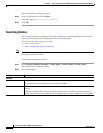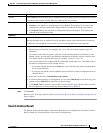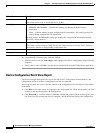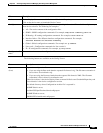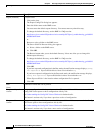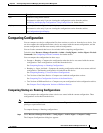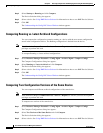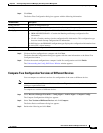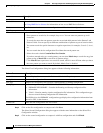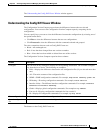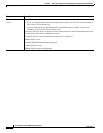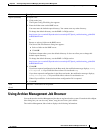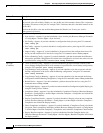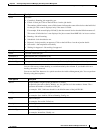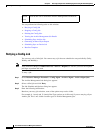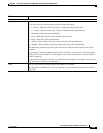
8-62
User Guide for Resource Manager Essentials 4.1
OL-11714-01
Chapter 8 Archiving Configurations and Managing Them Using Archive Management
Comparing Configuration
The Select First Configuration dialog box appears with the following information:
Step 4 Click on the first configuration to compare and click Next.
The Select Second Configuration dialog box appears with the same information as the Select First
Configuration window.
Step 5 Click on the second configuration to compare it with first configuration and click Finish.
Field Description
Left Pane
Device Selector Select the devices.
See Using RME Device Selector for information on how to use RME Device Selector.
Vers io n Select Latest to view the most recent configuration or All to view all configuration versions.
Right Pane
Pattern Details Perform the following tasks:
1. Enter patterns to search for, for example, http server. You can enter text patterns up to 64
characters.
To search for more than one pattern, enter the second and third patterns in the Pattern 2 and
Pattern 3 fields. You can specify ten different combinations of patterns as part of search criteria.
You cannot search for special characters or regular expressions, for example, Control-C, boot*,
etc.
You can search the device configuration file without the search pattern too.
2. Select the search criteria Contains/Does Not Contain.
If you have entered string as a search pattern, you can select Match Any to search for any given
pattern string or Match All to search for all pattern strings.
3. Click Match Case to perform a case-sensitive search, which is more efficient when you know
the exact pattern you want to match. By default, Match Case is disabled.
Column Name Description
Device Name Device Display Name as entered in Device and Credential Repository.
Config Version Versions of configuration file.
File Type Defines the configuration file type that is either Running or Startup configuration.
Config Type Defines the type of configuration PRIMARY, SECONDARY, or VLAN.
• PRIMARY/SECONDARY—Contains the Running and Startup configuration files
information.
• VLAN—Contains running vlan.dat configuration file information. This configuration type
does not contain Startup configuration file information.
For ONS devices, the PRIMARY configuration type displays the configuration information from
the active CPU, at that instance.
Created On Date and time configuration file was created.



